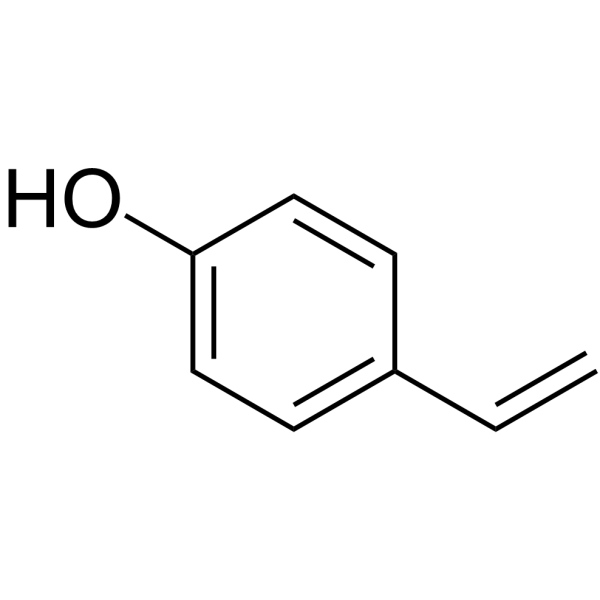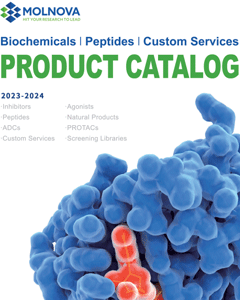
4-Vinylphenol
CAS No. 2628-17-3
4-Vinylphenol( —— )
Catalog No. M26541 CAS No. 2628-17-3
4-Vinylphenol is the metabolite of p-coumaric and ferulic acid by lactic acid bacteria in wine found in Hedyotis diffusa Willd. 4-Vinylphenol induces apoptosis in vivo.
Purity : >98% (HPLC)
 COA
COA
 Datasheet
Datasheet
 HNMR
HNMR
 HPLC
HPLC
 MSDS
MSDS
 Handing Instructions
Handing Instructions
| Size | Price / USD | Stock | Quantity |
| 100MG | 45 | Get Quote |


|
| 200MG | Get Quote | Get Quote |


|
| 500MG | Get Quote | Get Quote |


|
| 1G | Get Quote | Get Quote |


|
Biological Information
-
Product Name4-Vinylphenol
-
NoteResearch use only, not for human use.
-
Brief Description4-Vinylphenol is the metabolite of p-coumaric and ferulic acid by lactic acid bacteria in wine found in Hedyotis diffusa Willd. 4-Vinylphenol induces apoptosis in vivo.
-
Description4-Vinylphenol is the metabolite of p-coumaric and ferulic acid by lactic acid bacteria in wine found in Hedyotis diffusa Willd. 4-Vinylphenol induces apoptosis in vivo.(In Vitro):4-Vinylphenol (100 μg/mL) significantly increases the expressions of caspase 3, likely sensitizing CSC-enriched MDAMB-231 cells to apoptosis. 4-Vinylphenol (50, 100 μg/mL) significantly suppresses cell proliferation in CSC-enriched MDA-MB-231 cells. 4-Vinylphenol (12.5-200 μg/mL) significantly reduces cell viability in parental MDA-MB-231 cells, and the IC50 value is 109 μg/mL. 4-Vinylphenol (0.15, 0.3 μg/mL) reduces sphere?formation and vimentin expression on CSCs in breast cancer. 4-Vinylphenol significantly reduces ALDH1A1 expression by 50% in CSC-enriched MDA-MB-231 cells.
-
In Vitro4-Vinylphenol (12.5-200 μg/mL) significantly reduces cell viability in parental MDA-MB-231 cells, and the IC50 value is 109 μg/mL. 4-Vinylphenol (0.15 or 0.3 μg/mL; 3 days) reduces sphere?formation and vimentin expression on CSCs in breast cancer. 4-Vinylphenol (50, 100 μg/mL; 72 hours) significantly suppresses cell proliferation in CSC-enriched MDA-MB-231 cells. 4-Vinylphenol significantly reduces ALDH1A1 expression by 50% in CSC-enriched MDA-MB-231 cells. 4-Vinylphenol (100 μg/mL) significantly increases the expressions of caspase 3, likely sensitizing CSC-enriched MDAMB-231 cells to apoptosis.
-
In Vivo——
-
Synonyms——
-
PathwayApoptosis
-
TargetApoptosis
-
RecptorHCV NS5A
-
Research Area——
-
Indication——
Chemical Information
-
CAS Number2628-17-3
-
Formula Weight120.151
-
Molecular FormulaC8H8O
-
Purity>98% (HPLC)
-
SolubilityIn Vitro:?DMSO : 100 mg/mL (832.29 mM)
-
SMILESOc1ccc(C=C)cc1
-
Chemical Name——
Shipping & Storage Information
-
Storage(-20℃)
-
ShippingWith Ice Pack
-
Stability≥ 2 years
Reference
1.Gao Y, et al. Coblopasvir and sofosbuvir for treatment of chronic hepatitis C virus infection in China: A single-arm, open-label, phase 3 trial. Liver Int. 2020;40(11):2685-2693.
molnova catalog



related products
-
Benzyl selenocyanate
Benzyl selenocyanate is a chemopreventive agent that effectively inhibits chemically induced tumors at both initiation and postinitiation stages in animal models.
-
physalin F
Physalin F is a natural blocker of CaV2.3 (R-type) and CaV2.2 (N-type) voltage-gated calcium channels.It is a secosteroid with potent anti-inflammatory and immunomodulatory activities.
-
Eriocalyxin B
Eriocalyxin B induces apoptosis and cell cycle arrest in pancreatic adenocarcinoma cells through caspase- and p53-dependent pathways, should be considered a candidate for pancreatic cancer treatment.



 Cart
Cart
 sales@molnova.com
sales@molnova.com


